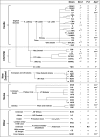Common inbred strains of the laboratory mouse that are susceptible to infection by mouse xenotropic gammaretroviruses and the human-derived retrovirus XMRV
- PMID: 20943975
- PMCID: PMC3004341
- DOI: 10.1128/JVI.01863-10
Common inbred strains of the laboratory mouse that are susceptible to infection by mouse xenotropic gammaretroviruses and the human-derived retrovirus XMRV
Abstract
Laboratory mouse strains carry endogenous copies of the xenotropic mouse leukemia viruses (X-MLVs), named for their inability to infect cells of the laboratory mouse. This resistance to exogenous infection is due to a nonpermissive variant of the XPR1 gammaretrovirus receptor, a resistance that also limits in vivo expression of germ line X-MLV proviruses capable of producing infectious virus. Because laboratory mice vary widely in their proviral contents and in their virus expression patterns, we screened inbred strains for sequence and functional variants of the XPR1 receptor. We also typed inbred strains and wild mouse species for an endogenous provirus, Bxv1, that is capable of producing infectious X-MLV and that also contributes to the generation of pathogenic recombinant MLVs. We identified the active Bxv1 provirus in many common inbred strains and in some Japanese Mus molossinus mice but in none of the other wild mouse species that carry X-MLVs. Our screening for Xpr1 variants identified the permissive Xpr1(sxv) allele in 7 strains of laboratory mice, including a Bxv1-positive strain, F/St, which is characterized by lifelong X-MLV viremia. Cells from three strains carrying Xpr1(sxv), namely, SWR, SJL, and SIM.R, were shown to be infectable by X-MLV and XMRV; these strains carry different alleles at Fv1 and vary in their sensitivities to specific X/P-MLV isolates and XMRV. Several strains with Xpr1(sxv) lack the active Bxv1 provirus or other endogenous X-MLVs and may provide a useful model system to evaluate the in vivo spread of these gammaretroviruses and their disease potential in their natural host.
Figures




Similar articles
-
Evolution of different antiviral strategies in wild mouse populations exposed to different gammaretroviruses.Curr Opin Virol. 2013 Dec;3(6):657-63. doi: 10.1016/j.coviro.2013.08.001. Epub 2013 Aug 28. Curr Opin Virol. 2013. PMID: 23992668 Free PMC article. Review.
-
Evolution of functional and sequence variants of the mammalian XPR1 receptor for mouse xenotropic gammaretroviruses and the human-derived retrovirus XMRV.J Virol. 2010 Nov;84(22):11970-80. doi: 10.1128/JVI.01549-10. Epub 2010 Sep 15. J Virol. 2010. PMID: 20844050 Free PMC article.
-
Endogenous gammaretrovirus acquisition in Mus musculus subspecies carrying functional variants of the XPR1 virus receptor.J Virol. 2013 Sep;87(17):9845-55. doi: 10.1128/JVI.01264-13. Epub 2013 Jul 3. J Virol. 2013. PMID: 23824809 Free PMC article.
-
Rmcf2, a xenotropic provirus in the Asian mouse species Mus castaneus, blocks infection by polytropic mouse gammaretroviruses.J Virol. 2005 Aug;79(15):9677-84. doi: 10.1128/JVI.79.15.9677-9684.2005. J Virol. 2005. PMID: 16014929 Free PMC article.
-
The mouse "xenotropic" gammaretroviruses and their XPR1 receptor.Retrovirology. 2010 Nov 30;7:101. doi: 10.1186/1742-4690-7-101. Retrovirology. 2010. PMID: 21118532 Free PMC article. Review.
Cited by
-
Evolution of different antiviral strategies in wild mouse populations exposed to different gammaretroviruses.Curr Opin Virol. 2013 Dec;3(6):657-63. doi: 10.1016/j.coviro.2013.08.001. Epub 2013 Aug 28. Curr Opin Virol. 2013. PMID: 23992668 Free PMC article. Review.
-
The avian XPR1 gammaretrovirus receptor is under positive selection and is disabled in bird species in contact with virus-infected wild mice.J Virol. 2013 Sep;87(18):10094-104. doi: 10.1128/JVI.01327-13. Epub 2013 Jul 10. J Virol. 2013. PMID: 23843647 Free PMC article.
-
No evidence of XMRV in prostate cancer cohorts in the Midwestern United States.Retrovirology. 2011 Mar 29;8:23. doi: 10.1186/1742-4690-8-23. Retrovirology. 2011. PMID: 21447170 Free PMC article.
-
Endogenous retrovirus induces leukemia in a xenograft mouse model for primary myelofibrosis.Proc Natl Acad Sci U S A. 2014 Jun 10;111(23):8595-600. doi: 10.1073/pnas.1401215111. Epub 2014 May 27. Proc Natl Acad Sci U S A. 2014. PMID: 24912157 Free PMC article.
-
Selective sweeps versus introgression - population genetic dynamics of the murine leukemia virus receptor Xpr1 in wild populations of the house mouse (Mus musculus).BMC Evol Biol. 2015 Nov 10;15:248. doi: 10.1186/s12862-015-0528-5. BMC Evol Biol. 2015. PMID: 26555287 Free PMC article.
References
-
- Aaronson, S. A., G. J. Todaro, and E. M. Scolnick. 1971. Induction of murine C-type viruses from clonal lines of virus-free BALB/3T3 cells. Science 174:157-159. - PubMed
-
- Beck, J. A., S. Lloyd, M. Hafezparast, M. Lennon-Pierce, J. T. Eppig, M. F. W. Festing, and E. M. C. Fisher. 2000. Genealogies of mouse inbred strains. Nat. Genet. 24:23-25. - PubMed
-
- Chattopadhyay, S. K., M. R. Lander, S. Gupta, E. Rands, and D. R. Lowy. 1981. Origin of mink cytopathic focus-forming (MCF) viruses: comparison with ecotropic and xenotropic murine leukemia virus genomes. Virology 113:465-483. - PubMed
-
- Cloyd, M. W., M. M. Thompson, and J. W. Hartley. 1985. Host range of mink cell focus-inducing viruses. Virology 140:239-248. - PubMed
Publication types
MeSH terms
Substances
Grants and funding
LinkOut - more resources
Full Text Sources
Molecular Biology Databases
Research Materials
Miscellaneous

